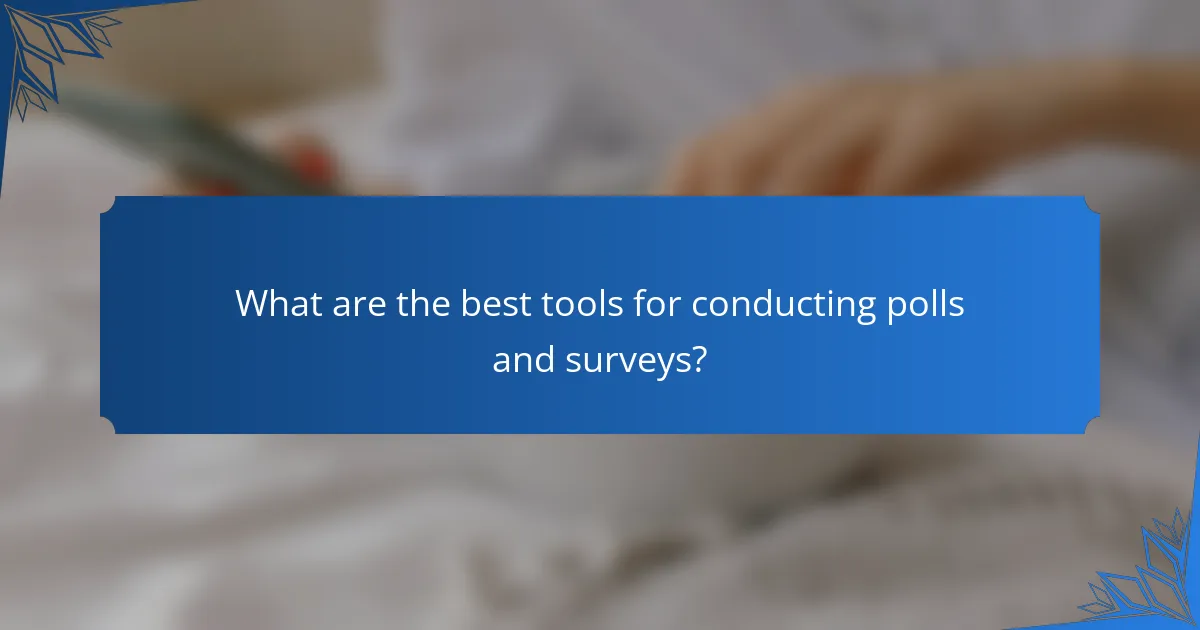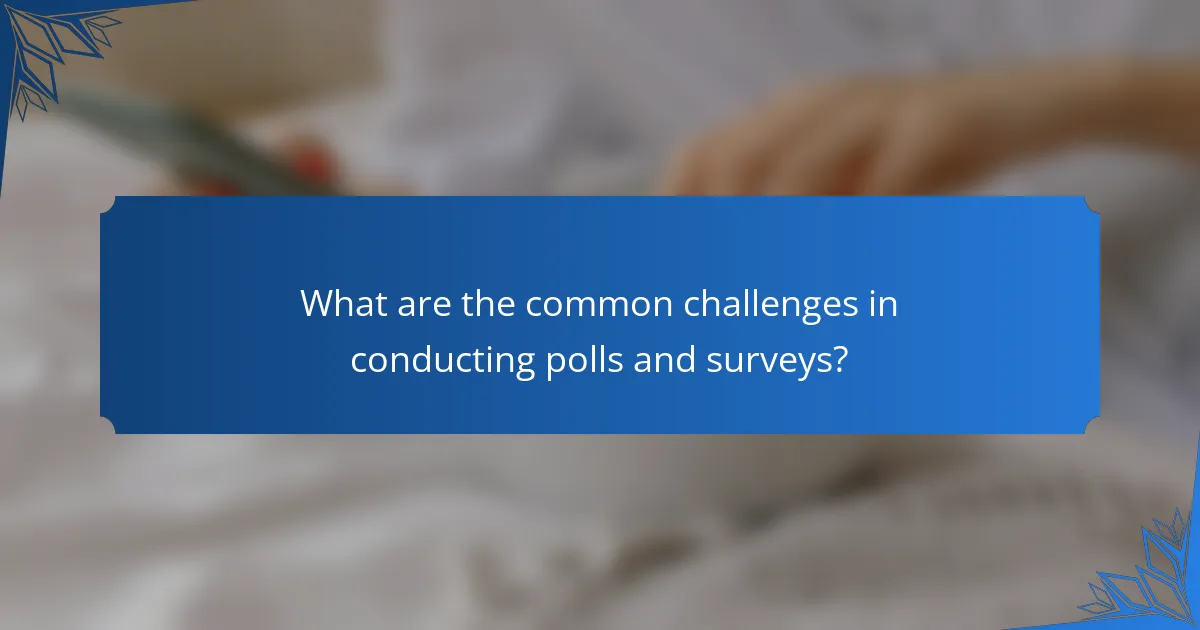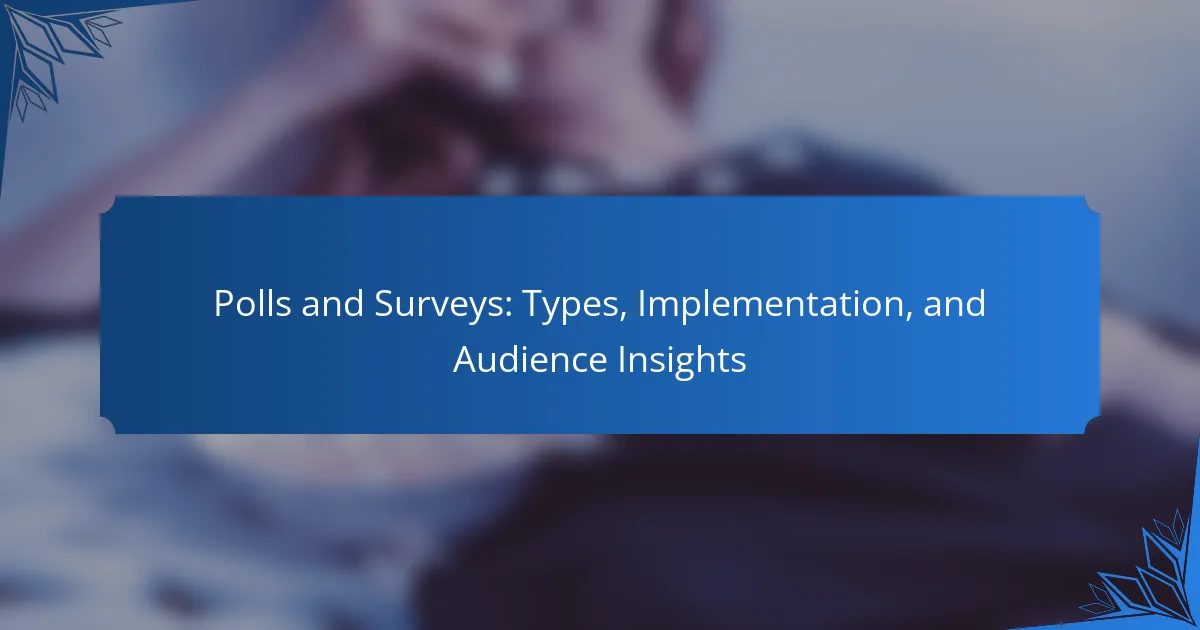Polls and surveys are essential tools for gathering audience insights, offering various methods such as online surveys, telephone polls, and focus groups. Effective implementation requires clear objectives, careful audience selection, and well-designed questions to ensure actionable data. Utilizing the right tools, like SurveyMonkey or Google Forms, can enhance the quality and efficiency of the data collection process.

What types of polls and surveys are most effective in the US?
The most effective types of polls and surveys in the US include online surveys, telephone polls, focus groups, in-person surveys, and mobile polls. Each method has unique advantages and considerations that can influence the quality of insights gathered.
Online surveys
Online surveys are widely used due to their cost-effectiveness and ability to reach a broad audience quickly. They typically involve sending questionnaires via email or hosting them on websites, allowing respondents to complete them at their convenience.
To maximize response rates, ensure surveys are mobile-friendly and concise, ideally taking no more than 10 minutes to complete. Incentives, such as gift cards or entry into a prize draw, can also encourage participation.
Telephone polls
Telephone polls involve calling respondents to gather their opinions, often using random digit dialing to ensure a representative sample. This method can yield high-quality data, especially for reaching demographics less engaged online.
However, response rates have declined in recent years, so it’s crucial to keep calls brief and respectful. Consider using a mix of landline and mobile numbers to improve reach.
Focus groups
Focus groups consist of small, diverse groups of participants discussing specific topics guided by a moderator. This qualitative method provides deep insights into attitudes and motivations that quantitative surveys may miss.
When conducting focus groups, aim for 6-10 participants and ensure a comfortable environment. Record sessions for analysis, and be aware of group dynamics that may influence individual responses.
In-person surveys
In-person surveys involve face-to-face interactions, often conducted in public places or events. This method allows for immediate clarification of questions and can lead to higher engagement.
However, in-person surveys can be time-consuming and costly. Train surveyors to be polite and professional, and consider the location and timing to maximize participation.
Mobile polls
Mobile polls leverage SMS or app notifications to reach respondents directly on their phones. This method is particularly effective for quick feedback and can engage users in real-time.
Keep surveys short, ideally under 5 questions, to accommodate the mobile format. Ensure that questions are clear and straightforward to maintain high response rates.

How to implement polls and surveys for audience insights?
Implementing polls and surveys effectively allows organizations to gather valuable audience insights that can inform decision-making. The process involves defining clear objectives, selecting the right audience, choosing appropriate platforms, and designing questions that yield actionable data.
Define objectives
Clearly defined objectives are essential for successful polls and surveys. Start by identifying what specific information you want to gather, such as customer satisfaction, product feedback, or market trends. This focus will guide the entire process and help you measure success effectively.
Consider using the SMART criteria—Specific, Measurable, Achievable, Relevant, and Time-bound—to refine your objectives. For example, instead of asking, “What do you think of our service?” specify, “Rate our customer service on a scale of 1-10 within the next month.”
Select target audience
Choosing the right target audience is crucial for obtaining relevant insights. Identify the demographic and psychographic characteristics of your ideal respondents, such as age, location, interests, and purchasing behavior. This ensures that the feedback you receive is applicable to your goals.
Utilize existing customer databases or social media analytics to help define your audience. For instance, if you’re launching a new product aimed at young adults, focus your survey on individuals aged 18-30 who have shown interest in similar products.
Choose the right platform
Selecting the appropriate platform for your polls and surveys can significantly impact response rates and data quality. Options include online survey tools, social media platforms, or email campaigns. Each platform has its strengths and weaknesses, so consider where your target audience is most active.
For example, if your audience is primarily on social media, using platforms like Instagram or Facebook for quick polls may yield better engagement. Conversely, for more in-depth surveys, dedicated survey tools like SurveyMonkey or Google Forms might be more effective.
Design effective questions
Well-crafted questions are key to gathering useful insights. Use clear and concise language, and avoid jargon that may confuse respondents. Open-ended questions can provide qualitative insights, while closed-ended questions are useful for quantitative analysis.
Consider including a mix of question types, such as multiple-choice, rating scales, and yes/no questions, to keep respondents engaged. For instance, instead of asking, “How do you feel about our product?” you might ask, “On a scale of 1-5, how satisfied are you with our product?” This format allows for easier analysis and comparison.

What are the best tools for conducting polls and surveys?
Some of the best tools for conducting polls and surveys include SurveyMonkey, Google Forms, Qualtrics, and Typeform. Each tool offers unique features that cater to different needs, such as ease of use, customization options, and analytical capabilities.
SurveyMonkey
SurveyMonkey is a popular online survey tool known for its user-friendly interface and robust analytics. It allows users to create surveys quickly with various question types, including multiple choice, rating scales, and open-ended questions.
Consider using SurveyMonkey if you need advanced features like branching logic or custom branding. The free version offers basic functionalities, while paid plans provide access to more sophisticated tools and analytics.
Google Forms
Google Forms is a free tool that integrates seamlessly with other Google Workspace applications. It is ideal for users who want a straightforward way to gather feedback without complex features.
This tool allows for real-time collaboration, making it easy to share surveys and analyze responses together. While it lacks some advanced analytics, it is a great option for simple surveys and quick polls.
Qualtrics
Qualtrics is a powerful survey platform designed for enterprise-level research. It offers extensive customization options, advanced analytics, and the ability to conduct complex surveys with multiple question types.
This tool is particularly useful for organizations needing in-depth insights and data analysis. However, it may be more expensive than other options, making it better suited for larger businesses or academic institutions.
Typeform
Typeform is known for its visually appealing and interactive survey designs. It focuses on user experience, making surveys engaging and easy to complete.
Typeform is ideal for businesses looking to enhance customer engagement through surveys. While it offers a free tier, advanced features such as logic jumps and custom branding are available in paid plans.

How to analyze poll and survey data for actionable insights?
To analyze poll and survey data effectively, focus on extracting meaningful insights that can guide decision-making. This involves utilizing statistical tools, identifying trends, and segmenting data to understand different audience perspectives.
Use statistical analysis software
Statistical analysis software, such as SPSS, R, or Python libraries, can streamline the process of analyzing poll and survey data. These tools allow for complex calculations, data visualization, and hypothesis testing, enabling you to derive insights quickly.
When selecting software, consider factors like ease of use, cost, and the specific analytical features you need. Many platforms offer free versions or trials, which can be useful for smaller projects or initial analyses.
Identify key trends
Identifying key trends in your data is crucial for understanding shifts in public opinion or consumer behavior. Look for patterns over time, such as increasing or decreasing responses to specific questions, which can indicate changing attitudes.
Utilize visual aids like graphs or charts to highlight these trends clearly. For example, a line graph showing survey results over several months can effectively illustrate a growing concern or interest among respondents.
Segment data by demographics
Segmenting data by demographics, such as age, gender, income, or location, provides deeper insights into how different groups respond to your polls or surveys. This approach helps tailor strategies to specific audiences, enhancing engagement and effectiveness.
For instance, if younger respondents show a preference for a particular product, marketing efforts can be adjusted to target that demographic more effectively. Always ensure that your sample size is adequate for each segment to maintain statistical validity.

What are the common challenges in conducting polls and surveys?
Conducting polls and surveys often presents several challenges that can impact the quality and reliability of the data collected. Key issues include low response rates, bias in questions, and data privacy concerns, each of which can significantly affect the outcomes and interpretations of survey results.
Low response rates
Low response rates are a frequent challenge in polls and surveys, often leading to unrepresentative samples. Typical response rates can vary widely, generally ranging from 10% to 30%, depending on the method of distribution and the target audience.
To improve response rates, consider using incentives, simplifying the survey process, and ensuring that the survey is accessible across various platforms. Personalizing invitations and reminders can also encourage participation.
Bias in questions
Bias in questions can skew survey results and misrepresent public opinion. Leading or loaded questions can influence respondents’ answers, resulting in data that does not accurately reflect their true views.
To minimize bias, ensure questions are neutral and straightforward. Pre-testing questions with a small group can help identify potential biases before the survey is widely distributed. Aim for clarity and avoid jargon that may confuse respondents.
Data privacy concerns
Data privacy concerns are increasingly important in the context of polls and surveys, as respondents are wary of how their information will be used. Compliance with regulations such as GDPR in Europe or CCPA in California is essential to build trust and encourage participation.
To address privacy concerns, clearly communicate how data will be collected, used, and protected. Offering anonymity and allowing respondents to opt-out of data sharing can also enhance trust and improve response rates.



